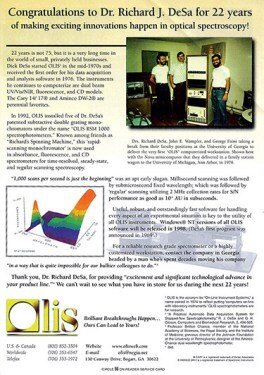The Definitive Guide for Uv/vis
Wiki Article
The smart Trick of Spectrophotometers That Nobody is Talking About
Table of ContentsMore About Circularly Polarized LuminescenceSome Known Questions About Uv/vis/nir.Some Known Factual Statements About Circularly Polarized Luminescence Spectrophotometers Things To Know Before You BuyCircularly Polarized Luminescence Fundamentals Explained

Spectrophotometry is a tool that hinges on the quantitative analysis of molecules depending on how much light is taken in by colored compounds.
The Facts About Circular Dichroism Revealed
A spectrophotometer is typically utilized for the measurement of transmittance or reflectance of services, transparent or opaque solids, such as sleek glass, or gases. Although many biochemicals are colored, as in, they absorb visible light and therefore can be measured by colorimetric treatments, even colorless biochemicals can often be converted to colored substances suitable for chromogenic color-forming reactions to yield compounds suitable for colorimetric analysis.: 65 Nevertheless, they can likewise be created to measure the diffusivity on any of the noted light varieties that generally cover around 2002500 nm utilizing various controls and calibrations.An example of an experiment in which spectrophotometry is utilized is the determination of the stability constant of an option. A particular chemical reaction within an option might happen in a forward and reverse instructions, where reactants form products and products break down into reactants. At some time, this chain reaction will reach a point of balance called a balance point.
Getting The Circular Dichroism To Work
The amount of light that passes through the solution is indicative of the concentration of certain chemicals that do not enable light to travel through. The absorption of light is due to the interaction of light with the electronic and vibrational modes of particles. Each type of molecule has an individual set of energy levels related to the makeup of its chemical bonds and nuclei and thus will absorb light of specific wavelengths, or energies, resulting in unique spectral homes.
They are extensively used in many markets consisting of semiconductors, laser and optical manufacturing, printing and forensic examination, as well as in laboratories for the study of chemical substances. Spectrophotometry is frequently used in measurements of enzyme activities, decisions of protein concentrations, determinations of enzymatic kinetic constants, and measurements of ligand binding reactions.: 65 Ultimately, a spectrophotometer is able to determine, depending on the control or calibration, what compounds are present in a target and exactly how much through estimations of observed wavelengths.
Developed by Arnold O. Beckman in 1940 [], the spectrophotometer was created with the aid of his associates at his company National Technical Laboratories established in 1935 which would end up being Beckman Instrument Company and ultimately Beckman Coulter. This would come as a service to the formerly produced spectrophotometers which were not able to take in the ultraviolet correctly.
The Basic Principles Of Circular Dichroism
It would be found that this did not give acceptable outcomes, for that reason in Design B, there was a shift from a glass to a quartz prism which permitted much better absorbance outcomes - circularly polarized luminescence (https://visual.ly/users/julieanndesalorenz30606/portfolio). From there, Design C was born with a change to the wavelength resolution which wound up having 3 units of it producedIt irradiates the sample with polychromatic light which the sample absorbs depending upon its homes. It is transmitted back by grating the photodiode variety which detects the wavelength area of the spectrum. Ever since, the creation and execution of spectrophotometry devices has increased immensely and has turned into one of the most ingenious instruments of our time.

The 20-Second Trick For Spectrophotometers
Historically, spectrophotometers utilize a monochromator containing a diffraction grating to produce the analytical spectrum. The grating can either be movable or fixed. If a single detector, such as a photomultiplier tube or photodiode is utilized, the grating can be scanned step-by-step (scanning spectrophotometer) so that the detector can measure the light strength at each wavelength (which will correspond to each "step").In such systems, the grating is repaired and the strength of each wavelength of light is measured by a different detector in the selection. When making transmission measurements, the spectrophotometer quantitatively compares the fraction of light that passes through a recommendation option and a test service, then digitally compares the strengths of the two signals and calculates the percentage of transmission of the sample compared to the referral standard.

Report this wiki page